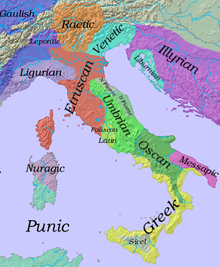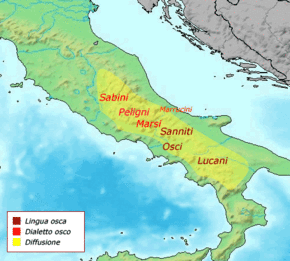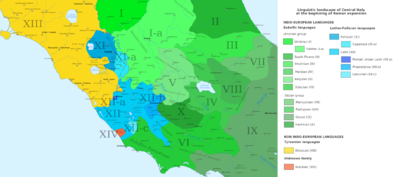Oscan language
| Oscan | |
|---|---|
 Denarius of Marsican Confederation with Oscan legend | |
| Native to | Samnium, Campania, Lucania, Calabria and Abruzzo |
| Region | south and south-central Italy |
| Extinct | >79 CE[1] |
Indo-European
| |
| Old Italic alphabet | |
| Language codes | |
| ISO 639-3 | osc |
osc | |
| Glottolog | osca1244 |
 Approximate distribution of languages in Iron Age Italy in the sixth century BCE | |
Oscan is an extinct Indo-European language of southern Italy. The language is also the namesake of the language group to which it belonged. As a member of the Italic languages, Oscan is therefore a sister language to Latin and Umbrian.
Oscan was spoken by a number of tribes, including the Samnites,[3] the Aurunci (Ausones), and the Sidicini. The latter two tribes were often grouped under the name "Osci". The Oscan group is part of the Osco-Umbrian or Sabellic family, and includes the Oscan language and three variants (Hernican, Marrucinian and Paelignian) known only from inscriptions left by the Hernici, Marrucini and Paeligni, minor tribes of eastern central Italy. The language was spoken until approximately CE 100.[2]
Evidence[]

Oscan is known from inscriptions dating as far back as the 5th century BCE. The most important Oscan inscriptions are the Tabula Bantina, the Oscan Tablet or Tabula Osca,[4] and the . In Apulia, Oscan are also the legends of the ancient currencies (dating back to before 300 BC)[5] found at Teanum Apulum.[6] Oscan graffiti on the walls of Pompeii indicate its persistence in at least one urban environment well into the 1st century of the common era.[7]
In total, as of 2017, there were 800 Oscan texts, with a rapid expansion in recent decades.[8] Oscan was written in various scripts depending on time period and location, including the "native" Oscan script, the South Oscan script which was based on Greek, and the ultimately prevailing Roman Oscan script.[8]
Demise[]
In coastal zones of Southern Italy, Oscan is thought to have survived three centuries of bilingualism with Greek between 400 and 100 BCE, making it "an unusual case of stable societal bilingualism" wherein neither language became dominant or caused the death of the other; however, over the course of the Roman period both Oscan and Greek would be progressively effaced from Southern Italy, excepting the controversial possibility of Griko representing a continuation of ancient dialects of Greek.[8] Oscan's usage declined following the Social War.[9] However, graffiti in towns across the Oscan speech area indicate it remained in good health after this.[1] A very strong piece of evidence is the presence of Oscan graffiti on walls of Pompeii that were reconstructed after the earthquake of CE 62,[10][11] and must therefore have been written between CE 62 and 79.[1]
General characteristics[]
Oscan had much in common with Latin, though there are also many striking differences, and many common word-groups in Latin were absent or represented by entirely different forms. For example, Latin volo, velle, volui, and other such forms from the Proto-Indo-European root *wel- ('to will') were represented by words derived from *gher ('to desire'): Oscan herest ('(s)he shall want, (s)he shall desire', German cognate 'begehren', English cognate 'yearn') as opposed to Latin volent (id.). Place was represented by the hapax slaagid (place), which Italian linguist Alberto Manco has linked to a surviving local toponym. Distant cognate of the Latin locus, both derived from Proto-Italic "stlokos".[12]
In phonology too, Oscan exhibited a number of clear differences from Latin: thus, Oscan 'p' in place of Latin 'qu' (Osc. pis, Lat. quis) (compare the similar P-Celtic/Q-Celtic cleavage in the Celtic languages); 'b' in place of Latin 'v'; medial 'f' in contrast to Latin 'b' or 'd' (Osc. mefiai, Lat. mediae).[13]
Oscan is considered to be the most conservative of all the known Italic languages, and among attested Indo-European languages it is rivaled only by Greek in the retention of the inherited vowel system with the diphthongs intact.[14]
Writing system[]

Alphabet[]
Oscan was originally written in a specific "Oscan alphabet", one of the Old Italic scripts derived from (or cognate with) the Etruscan alphabet. Later inscriptions are written in the Greek and Latin alphabets.[15]
The "Etruscan" alphabet[]
The Osci probably adopted the archaic Etruscan alphabet during the 7th century BCE, but a recognizably Oscan variant of the alphabet is attested only from the 5th century BCE; its sign inventory extended over the classical Etruscan alphabet by the introduction of lowered variants of I and U, transcribed as Í and Ú. Ú came to be used to represent Oscan /o/, while U was used for /u/ as well as historical long */oː/, which had undergone a sound shift in Oscan to become ~[uː].

The Z of the native alphabet is pronounced [ts].[16] The letters Ú and Í are "differentiations" of U and I, and do not appear in the oldest writings.[16] The Ú represents an o-sound,[13] and Í is a higher-mid [ẹ]. Doubling of vowels was used to denote length but a long I is written IÍ.[16]
The "Greek" alphabet[]
Oscan written with the Greek alphabet was identical to the standard alphabet with the addition of two letters: one for the native alphabet's H and one for its V.[13] The letters η and ω do not indicate quantity.[13] Sometimes, the clusters ηι and ωϝ denote the diphthongs /ei/ and /ou/ respectively while ει and oυ are saved to denote monophthongs /iː/ and /uː/ of the native alphabet.[13] At other times, ει and oυ are used to denote diphthongs, in which case o denotes the /uː/ sound.[13]
The "Latin" alphabet[]
When written in the Latin alphabet, the Oscan Z does not represent [ts] but instead [z], which is not written differently from [s] in the native alphabet.[15]
Transliteration[]
When Oscan inscriptions are quoted, it is conventional to transliterate those in the "Oscan" alphabet into Latin boldface, those in the "Latin" alphabet into Latin italics, and those in the "Greek" alphabet into the modern Greek alphabet. Letters of all three alphabets are represented in lower case.[17]
History of sounds[]
Vowels[]
Vowels are regularly lengthened before ns and nct (in the latter of which the n is lost) and possibly before nf and nx as well.[18] Anaptyxis, the development of a vowel between a liquid or nasal and another consonant, preceding or following, occurs frequently in Oscan; if the other consonant precedes, the new vowel is the same as that of the preceding vowel. If the other consonant follows, the new vowel is the same as that of the following vowel.[19]
Monophthongs[]
A[]
Short a remains in most positions.[20] Long ā remains in an initial or medial position. Final ā starts to sound similar to [ɔː] so that it is written ú or, rarely, u.[21]
E[]
Short e "generally remains unchanged;" before a labial in a medial syllable, it becomes u or i and before another vowel, e becomes í.[22] Long ē becomes the sound of í or íí.[23]
I[]
Short i becomes written í.[24] Long ī is spelt with i but when written with doubling as a mark of length with ií.[25]
O[]
Short o remains mostly unchanged, written ú;[26] before a final -m, o becomes more like u.[27] Long ō becomes denoted by u or uu.[28]
U[]
Short u generally remains unchanged; after t, d, n, the sound becomes that of iu.[29] Long ū generally remains unchanged; it may have changed to an ī sound for final syllables.[30]
Diphthongs[]
The sounds of diphthongs remain unchanged.[14]
Consonants[]
S[]
In Oscan, S between vowels did not undergo rhotacism as it did in Latin; but it was voiced, becoming the sound /z/. However, between vowels, the original cluster rs developed either to a simple r with lengthening on the preceding vowel, or to a long rr (as in Latin), and at the end of a word, original rs becomes r just as in Latin. Unlike in Latin, the s is not dropped from the consonant clusters sm, sn, sl.[31]
Example of an Oscan text[]
Taken from the
Ekkum svaí píd herieset trííbarak avúm tereí púd liímítúm pernúm púís herekleís fíísnú mefiú íst, ehtrad feíhúss pús herekleís fíísnam amfret, pert víam pússt íst paí íp íst, pústin slagím senateís suveís tanginúd tríbarakavúm líkítud. íním íúk tríbarakkiuf pam núvlanús tríbarakattuset íúk tríbarakkiuf íním úíttiuf abellanúm estud. avt púst feíhúís pús físnam amfret, eíseí tereí nep abellanús nep núvlanús pídum tríbarakattíns. avt the savrúm púd eseí tereí íst, pún patensíns, múíníkad tanginúd patensíns, íním píd eíseí thesavreí púkkapíd eestit aíttíúm alttram alttrús herríns. avt anter slagím abellanam íním núvlanam súllad víú uruvú íst. pedú íst eísaí víaí mefiaí teremenniú staíet.
In Latin:
Item si quid volent aedificare in territorio quod limitibus tenus quibus Herculis fanum medium est, extra muros, qui Herculis fanum ambiunt, [per] viam positum est, quae ibi est, pro finibus senatus sui sententia, aedificare liceto. Et id aedificium quam Nolani aedificaverint, id aedificium et usus Abellanorum esto. At post muros qui fanum ambiunt, in eo territorio nec Avellani nec Nolani quidquam aedificaverint. At thesaurum qui in eo territorio est, cum paterent, communi sententia paterent, et quidquid in eo thesauro quandoque extat, portionum alteram alteri caperent. At inter fines Abellanos et Nolanos ubique via curva est, [pedes] est in ea via media termina stant.
In English:
And if anyone shall want to build on the land within the boundaries where the temple of Hercules stands in the middle, may the senate allow him to build outside of the walls that encircle the sanctuary of Hercules, across the road leads there. And a building that a man from Nola builds, shall be of use by the people of Nola. And a building that a man from Abella builds, shall be of use by the people of Abella. But beyond the wall that encircle the sanctuary, in that territory neither the Abellans nor the Nolans may build anything. But the treasury that is in that territory, when it is opened it shall be opened following a shared decision, and whatever is in that treasury, they shall share equally amongst them. But the road that as between the slagi- of Abella and Nola is a communal road. The boundaries stand in the middle of this road.
See also[]
- Ancient peoples of Italy
References[]
- ^ Jump up to: a b c Schrijver, Peter (2016). "Oscan love of Rome". Glotta. 92 (1): 223–226. doi:10.13109/glot.2016.92.1.223. ISSN 0017-1298. Page 2 in the online version.
- ^ Jump up to: a b "Oscan". Ancient Scripts. Archived from the original on 25 October 2015. Retrieved 4 November 2011.
- ^ Davide Monaco. "Samnites The People". Sanniti.info. Retrieved 4 November 2011.
- ^ "Samnites Oscan Tablet of Agnone".
- ^ "Teano Apulo". Treccani (in Italian).
- ^ Salvemini Biagio, Massafra Angelo (May 2014). Storia della Puglia. Dalle origini al Seicento (in Italian). Laterza. ISBN 9788858113882.
- ^ Freeman, Philip (1999). The Survival of Etruscan. Page 82: "Oscan graffiti on the walls of Pompeii show that non-Latin languages could thrive in urban locations in Italy well into the 1st century CE."
- ^ Jump up to: a b c McDonald, K. L. (2017). "Fragmentary ancient languages as “bad data”: towards a methodology for investigating multilingualism in epigraphic sources." Pages 4–6
- ^ Lomas, Kathryn, "The Hellenization of Italy", in Powell, Anton. The Greek World. Page 354.
- ^ Cooley, Alison (2002)."The survival of Oscan in Roman Pompeii", in A.E. Cooley (ed.), Becoming Roman, Writing Latin? Literacy and Epigraphy in the Roman West, Portsmouth (Journal of Roman Archaeology), 77–86. Page 84
- ^ Cooley (2014). Pompeii and Herculaneum: A Sourcebook. New York – London (Routledge). Page 104.
- ^ Alberto Manco, "Sull’osco *slagi-", AIΩN Linguistica 28, 2006.
- ^ Jump up to: a b c d e f Buck, Carl Darling (2007) [1904]. A Grammar of Oscan and Umbrian: With A Collection of Inscriptions and a Glossary. Kessinger Publishing. pp. 7–8. ISBN 978-1432691325.
- ^ Jump up to: a b Buck, Carl Darling (2007) [1904]. A Grammar of Oscan and Umbrian: With A Collection of Inscriptions and a Glossary. Kessinger Publishing. p. 18. ISBN 978-1432691325.
- ^ Jump up to: a b Buck, Carl Darling (2007) [1904]. A Grammar of Oscan and Umbrian: With A Collection of Inscriptions and a Glossary. Kessinger Publishing. pp. 22–23. ISBN 978-1432691325.
- ^ Jump up to: a b c Buck, Carl Darling (2007) [1904]. A Grammar of Oscan and Umbrian: With A Collection of Inscriptions and a Glossary. Kessinger Publishing. p. 22. ISBN 978-1432691325.
- ^ Buck, Carl Darling (2007) [1904]. A Grammar of Oscan and Umbrian: With A Collection of Inscriptions and a Glossary. Kessinger Publishing. p. xvii. ISBN 978-1432691325.
- ^ Buck, Carl Darling (2007) [1904]. A Grammar of Oscan and Umbrian: With A Collection of Inscriptions and a Glossary. Kessinger Publishing. p. 47. ISBN 978-1432691325.
- ^ Buck, Carl Darling (2007) [1904]. A Grammar of Oscan and Umbrian: With A Collection of Inscriptions and a Glossary. Kessinger Publishing. p. 50. ISBN 978-1432691325.
- ^ Buck, Carl Darling (2007) [1904]. A Grammar of Oscan and Umbrian: With A Collection of Inscriptions and a Glossary. Kessinger Publishing. pp. 29–30. ISBN 978-1432691325.
- ^ Buck, Carl Darling (2007) [1904]. A Grammar of Oscan and Umbrian: With A Collection of Inscriptions and a Glossary. Kessinger Publishing. p. 30. ISBN 978-1432691325.
- ^ Buck, Carl Darling (2007) [1904]. A Grammar of Oscan and Umbrian: With A Collection of Inscriptions and a Glossary. Kessinger Publishing. pp. 31–32. ISBN 978-1432691325.
- ^ Buck, Carl Darling (2007) [1904]. A Grammar of Oscan and Umbrian: With A Collection of Inscriptions and a Glossary. Kessinger Publishing. p. 33. ISBN 978-1432691325.
- ^ Buck, Carl Darling (2007) [1904]. A Grammar of Oscan and Umbrian: With A Collection of Inscriptions and a Glossary. Kessinger Publishing. p. 34. ISBN 978-1432691325.
- ^ Buck, Carl Darling (2007) [1904]. A Grammar of Oscan and Umbrian: With A Collection of Inscriptions and a Glossary. Kessinger Publishing. p. 35. ISBN 978-1432691325.
- ^ Buck, Carl Darling (2007) [1904]. A Grammar of Oscan and Umbrian: With A Collection of Inscriptions and a Glossary. Kessinger Publishing. p. 36. ISBN 978-1432691325.
- ^ Buck, Carl Darling (2007) [1904]. A Grammar of Oscan and Umbrian: With A Collection of Inscriptions and a Glossary. Kessinger Publishing. p. 37. ISBN 978-1432691325.
- ^ Buck, Carl Darling (2007) [1904]. A Grammar of Oscan and Umbrian: With A Collection of Inscriptions and a Glossary. Kessinger Publishing. p. 38. ISBN 978-1432691325.
- ^ Buck, Carl Darling (2007) [1904]. A Grammar of Oscan and Umbrian: With A Collection of Inscriptions and a Glossary. Kessinger Publishing. p. 40. ISBN 978-1432691325.
- ^ Buck, Carl Darling (2007) [1904]. A Grammar of Oscan and Umbrian: With A Collection of Inscriptions and a Glossary. Kessinger Publishing. p. 41. ISBN 978-1432691325.
- ^ Buck, Carl Darling (2007) [1904]. A Grammar of Oscan and Umbrian: With A Collection of Inscriptions and a Glossary. Kessinger Publishing. pp. 73–76. ISBN 978-1432691325.
Sources[]
- Buck, Carl Darling (1904). A Grammar of Oscan and Umbrian with a Collection of Inscriptions and a Glossary. Internet Archive.
- Salvucci, Claudio R (1999). A Vocabulary of Oscan Including the Oscan and Samnite Glosses. Southampton, Pennsylvania: Evolution Publishing and Manufacturing Co.
Further reading[]
Linguistic Outlines:
- Prosdocimi, A.L. 1978. «L’osco». In Lingue e dialetti dell’Italia antica, a cura di Aldo Luigi Prosdocimi, 825–912. Popoli e civiltà dell’Italia antica 6. Roma - Padova: Biblioteca di storia patria.
Studies:
- Planta, R. von 1892-1897. Grammatik der oskisch-umbrischen Dialekte. 2 voll. Strassburg: K. J. Trubner.
- Buck, C. D. 1904 [1979/2]. A Grammar of Oscan and Umbrian. Boston: Ginn & Company.
- , Le lingue dell'Italia antica oltre il Latino, Rosenberg & Sellier, 1964. ISBN 9788870110241
- Lejeune, Michel. "Phonologie osque et graphie grecque". In: Revue des Études Anciennes. Tome 72, 1970, n°3-4. pp. 271–316. [DOI: https://doi.org/10.3406/rea.1970.3871] ; [www.persee.fr/doc/rea_0035-2004_1970_num_72_3_3871]
- Salvucci, Claudio R. 1999. A Vocabulary of Oscan: Including the Oscan and Samnite Glosses. Southampton, PA: Evolution Publishing.
- Untermann, J. 2000. Wörterbuch des Oskisch-Umbrischen. Heidelberg: C. Winter.
- McDonald, Katherine. 2015. Oscan in Southern Italy and Sicily: Evaluating Language Contact in a Fragmentary Corpus. Cambridge: Cambridge University Press. https://doi.org/10.1017/CBO9781316218457.
- Schrijver, Peter. 2016. "Oscan Love of Rome". Glotta 92 (1): 223–26.
- Zair, Nicholas. 2016. Oscan In The Greek Alphabet. Cambridge: Cambridge University Press. https://doi.org/10.1017/CBO9781107706422.
- Machajdíková, Barbora; Martzloff, Vincent. "Le pronom indéfini osque pitpit "quicquid" de Paul Diacre à Jacob Balde: morphosyntaxe comparée des paradigmes *kwi- kwi- du latin et du sabellique". In: Graeco-Latina Brunensia. 2016, vol. 21, iss. 1, pp. 73-118. ISSN 2336-4424. DOI: 10.5817/GLB2016-1-5
- Petrocchi, A., Wallace, R. 2019. Grammatica delle Lingue Sabelliche dell’Italia Antica. München: LINCOM GmbH. [ed. inglese. 2007]
Texts:
- Janssen, H.H. 1949. Oscan and Umbrian Inscriptions, Leiden.
- Vetter, E. 1953 Handbuch der italischen Dialekte, Heidelberg.
- Rix, H. 2002. Sabellische Texte. Heidelberg: C. Winter.
- Crawford, M. H. et al. 2011. Imagines Italicae. London: Institute of Classical Studies.
- Franchi De Bellis, A. 1988. Il cippo abellano. Universita Degli Studi Di Urbino.
- Del Tutto Palma, Loretta. 1983. La Tavola Bantina (sezione osca): Proposte di rilettura. Vol. 1. Linguistica, epigrafia, filologia italica, Quaderni di lavoro.
- Del Tutto Palma, L. (a cura di) 1996. La tavola di Agnone nel contesto italico. Atti del Convegno di studio (Agnone 13-15 aprile 1994). Firenze: Olschki.
- Franchi De Bellis, Annalisa. 1981. Le iovile capuane. Firenze: L.S. Olschki.
- Murano, Francesca. 2013. Le tabellae defixionum osche. Pisa ; Roma: Serra.
- Decorte, Robrecht. 2016. "Sine dolo malo: The Influence and Impact of Latin Legalese on the Oscan Law of the Tabula Bantina". Mnemosyne 69 (2): 276–91.
External links[]
| Library resources about Oscan language |
- "Languages and Cultures of Ancient Italy. Historical Linguistics and Digital Models", Project fund by the Italian Ministry of University and Research (P.R.I.N. 2017)
- Hare, JB (2005). "Oscan". wordgumbo. Retrieved 21 August 2010.
- Languages with Linglist code
- Osco-Umbrian languages
- Languages attested from the 5th century BC
- Languages extinct in the 1st century
- Osci
- Samnium